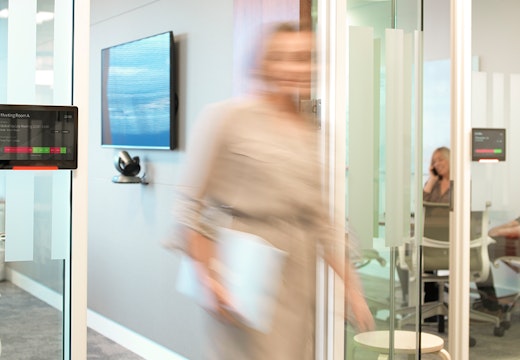How technology can help your return to the office
Employees are getting ready for a partial return to work - but it isn’t as easy as it sounds. Learn how technology can help you pull it off
A technology-led approach
With a post-pandemic business world emerging on the horizon, now is the time to start thinking about how the long-term return to the office can be executed effectively. While remote working has served its purpose through the eye of the Covid-19 storm, it is unlikely to be a widespread solution permanently: research of skilled employees by Slack late last year found that, in the future, 73 per cent want to work from the office at least some of the time.
From an employer perspective, however, getting employees back into the office is far more complex an undertaking than saying ‘OK, the office is open, see you 9am Monday’. There are a huge number of factors to take into account, in order to ensure employees feel safe and productive, that the needs of the business continue to be met, and that any Covid-19 regulations still in place are complied with.
Technology has a huge part to play in easing this process, and supporting new ways of working, both through the initial re-opening and on into the future. How this will apply to your business will vary from others, but there are seven key pillars where tech like workspace scheduling can make a real difference:
- Workplace purpose
It’s important to work out exactly what your office means to your business post-pandemic. Will it still be a primary place of work as it was before? Or will it become a hub for collaboration and socialisation as and when required? Defining the role of the physical office environment can help you assess everything else you need, including any relevant technology.
- Flexible working
For many businesses, adopting a flexible or ‘hybrid’ working model will be essential. Microsoft research has found that nearly half of the global workforce is planning to change employer now they can work remotely, and that remote job postings on LinkedIn have increased more than fivefold. How this works on a practical level needs careful consideration, and workspace scheduling technology can make this a seamless, stress-free experience.
- Covid security
The pandemic is by no means over, and in many countries, operational restrictions like capacity limits, contact tracing and social distancing are likely to remain in place for some time to come. Additionally, employees will also expect employers to adhere to these too, for their own safety. Workspace management technology can help manage these issues, and easily make adjustments to what is allowed as the regulations change.
- Workspace allocation
If hybrid workers want to come into the office, they want to be sure that they can access the workspace they need for the specific times they need it, and to be able to reserve it with ease. Rather than rely on emails or phone calls to overworked front-of-house staff, through a workspace booking solution, employees can search and book their desired space in moments through the web, mobile app or an add-in for Microsoft Outlook.
- Getting in and out
With so many people entering and exiting an office building at different times, the process of checking in and checking out needs to be smooth, and must also level out any peaks in order to keep reception areas Covid-secure. The ability for employees to automatically check in as they approach the entrance, and to have directions to their booked workspace provided to them through their workspace booking software, can help make this a fast and safe experience.
- Supporting collaboration
When different employees work in different places at different times, it can be difficult to bring them together for collaboration. Workspace scheduling means that an employee can check the availability of all relevant attendees and appropriate meeting spaces in moments and make a booking. They can also ensure that all audio-visual technology needed is in place for virtual attendees to take part.
- Responding to changes
How your office environment looks when you reopen may not be suitable for the demands of the months and years ahead. Workspaces may need reshaping to keep the office as valuable to the business and workforce as possible. A good workspace booing solution will allow floorplans to be quickly adjusted, so that old workspaces can be removed or repositioned, and so that new workspaces can be added and immediately opened up for booking.








